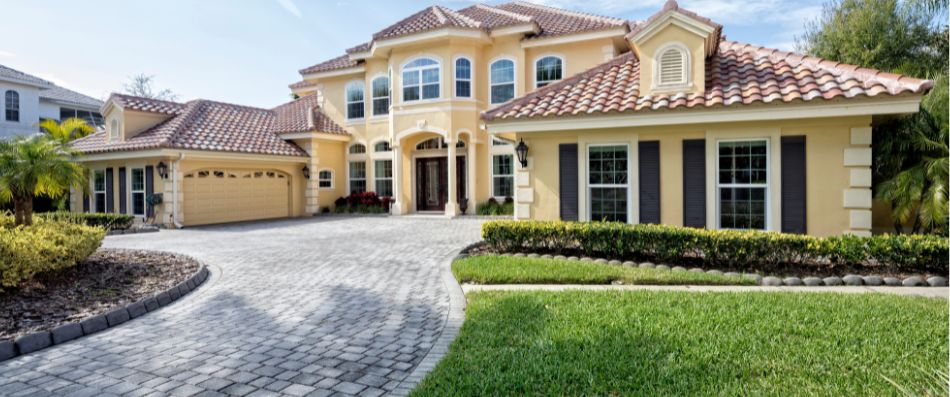Does your driveway’s weathered appearance negatively impact your home’s curb appeal? Even the most durable passage may deteriorate with time, so it’s important to consider your alternatives before revitalizing your exterior aesthetics with driveway repair. The centuries-old debate between resurfacing and replacement is at the forefront of path rehabilitation.
In this blog, we examine the details of these two strategies, revealing their unique benefits and limitations. This information will lead you through the routes of resurfacing and replacement, helping you pave the road to a passage that matches flawlessly with your vision and budget, whether you’re looking for a cost-effective transformation or striving for a total renewal.
Understanding Your Driveway’s Condition
Due to its functional and aesthetic significance, your roadway is essential to your house. However, it can show wear and tear with time due to constant exposure to the elements, vehicle traffic, and other environmental factors.
One of the primary solutions for addressing the deterioration is to repair it. Whether the path can be repaired or not, it’s critical to completely understand its condition before deciding on the best course of action for driveway repair.
Assessing Surface Damage
Start by carefully examining the road’s surface for passage repairs. Look out for cracks, potholes, and uneven spots. Small cracks and visible faults are frequently caused by freezing, melting cycles, and natural settling. If the superficial damage only affects the top layer, materializing the roadway can be an option, making it suitable for surface-level driveway repair.
The Extent of Structural Issues
Potholes, hollow spots, and deeper cracks indicate potential structural problems requiring more extensive road repair. These issues jeopardize your route stability and necessitate more complicated repairs or a replacement for a thorough driveway repair. If significant structural damage occurs, resurfacing your roadway may only be temporary; otherwise, the underlying problems will persist.
Drainage and Water Issues
Whether it has recently rained, pay attention to how the water is moving over your road to see whether it needs to be repaired. Inadequate drainage, puddles, and stagnant water can speed up deterioration.
An uneven surface or poor slope may occur if water collects in specific locations. Resurfacing can partially resolve these issues, but replacement offers the chance to fully address drainage issues as part of your driveway repair approach.
Age and Material
For driveway repair, consider your road’s age and the materials used to create it. Asphalt roadways typically last 20 to 30 years, whereas concrete driveways can last longer but are more prone to erode over time. If your path needs replacement but is past when it should be replaced but is still full of problems, replacing it as part of your driveway repair plan may be more cost-effective in the long run.
When to Resurface a Concrete Driveway
Signs of Concrete Driveway Deterioration
Consider looking for telltale signs, including surface fractures, slight spalling (concrete breaking off in little pieces), discoloration, and an uneven appearance. These problems indicate that the underlying structure of the concrete is still sound but that the top layer has been damaged. Resurfacing could work if the base of the road is still solid.
Benefits of Concrete Driveway Resurfacing
Resurfacing has several benefits, including a faster turnaround time, a lower cost than total replacement, and a more modern appearance. It enables you to take care of surface flaws while keeping the base of the current track intact. It also allows you to add ornamental details or textures to improve the appearance of your track.
How to Resurface a Concrete Driveway
Cleaning the current surface, using a bonding agent, pouring a fresh layer of stamped concrete mix, and smoothing it to provide a consistent finish are the steps involved in resurfacing. To give the new layer the required look, it might be stained, stamped, or colored. Proper preparation and application methods are crucial to guaranteeing the resurfaced driveway’s lifetime and functionality.
When to Replace a Concrete Driveway
Signs of Concrete Failure
Your driveway’s severe fractures, substantial spalling, deep potholes, or major submerged sections may indicate a weakened underlying base. Resurfacing may not be sufficient in light of the considerable damage, and replacement may be a better option.
Benefits of Concrete Driveway Replacement
Resurfacing has several benefits, including a faster turnaround time, a lower cost than total replacement, and a more modern appearance. It enables you to alter the path’s shape or size if needed. A brand-new roadway may boost home value and solve recurring maintenance issues brought on by an old one.
How to Replace a Concrete Driveway
A more involved process involves replacing a track. It entails dismantling and removing the old concrete, assessing and sometimes changing the foundation, and pouring fresh concrete. A successful roadway depends on accurate pouring processes, appropriate reinforcement, and foundation compaction. The newly formed surface must be dried and sealed after pouring to increase endurance.
Rejuvenate Your Old Driveway: Resurfacing vs. Replacement
Choosing between resurfacing and replacement is important, whether your track exhibits signs of wear and tear or just want to give it a new appearance. Before choosing, every alternative must be carefully considered because each has advantages and drawbacks of its own. We’ll discuss the most important things to consider when choosing whether to repair or resurface your roadway.
Whether your path shows signs of wear and tear or you want to give it a drastic facelift, your decision to resurface or replace it will have a big impact. Each choice has its charm, so it is important to think carefully before deciding.
We begin an enlightening examination of the fundamental components that ought to guide your decision-making when choosing between the two possibilities for the future of your road.
Whether to resurface the road or replace it is crucial for repair. It’s a decision that depends on a wide range of elements, each of which has benefits and disadvantages of its own. We deconstruct the crucial elements that demand your attention as you struggle to choose the full-scale makeover that replacement may offer or breathe new life into your track by resurfacing.
Long-Term Durability: Making the Right Choice
The durability of your roadway is a crucial consideration when choosing between replacement and resurfacing. Concrete Path resurfacing entails adding a fresh layer of concrete over the preexisting surface to correct small cracks, stains, and surface irregularities.
Nevertheless, the effectiveness of this method may not address underlying structural problems, and its lifespan is mainly dependent on the state of the current foundation.
On the other hand, replacement entails completely dismantling and replacing the current path with a new one. Provides the chance to treat surface-level and structural issues, providing a more substantial fix. While replacement often provides longer-lasting durability, balancing this against the higher cost and longer building time is important.
Cost of Concrete Driveway Resurfacing vs. Replacement
Resurfacing frequently costs less than total replacement. The size of the road, local labor costs, and the depth of the required repairs are a few examples of variables that might affect its cost. The average cost ranges from $3 to $10 per square foot. For instance, working on a 500-square-foot roadway may cost between $1,500 and $5,000.
The replacement cost, however, is often higher since it requires more labor. Higher costs result from using new materials, excavating, and disposing of the old track. Depending on the previously listed considerations, a new road can average anywhere from $8,000 to $25,000.
Choosing the Right Option for Your Driveway Repair
Making the best decision for your driveway repair requires careful consideration of several factors. These elements together influence the decision-making process, influencing anything from the degree of the damage and the available money to long-term goals and aesthetic preferences. You may confidently decide whether resurfacing or replacement is the best option to restore your road’s functionality and aesthetic appeal by carefully weighing these factors and getting professional guidance.
Factors to Consider
You should consider the following aspects while choosing between replacement and resurfacing:
Extent of Damage
Analyze the size of the cracks, potholes, and structural problems that may be present. While replacement is the best option for more significant damage, resurfacing is appropriate for minor surface defects.
Budget
Think about your financial restrictions when you are using this method. It can be better if you search for a more cost-effective solution.
Long-Term Plans
Consider how long you intend to remain at your residence. Resurfacing could be adequate if you’re considering selling soon. Replacement could provide greater value if you plan to remain for a while.
Aesthetic Preferences
Replacement provides additional design alternatives if you want to dramatically alter the appearance of your path.
Getting Quotes from Contractors
After weighing these, it’s wise to get quotations from trustworthy contractors, just like the experts at Riverview Concrete, for resurfacing and replacement choices. Compare the costs of these quotations and the specifics of the job they cover. You’ll have a better idea of what you’re getting for your money and be able to make a wise choice as a result.
The Pros and Cons of Resurfacing
Both positive and negative effects might result from revitalizing an old roadway. It’s important to assess the method’s advantages against any potential disadvantages before rejuvenating your old road. Several crucial points have been listed below.

Hiring Professionals for the Job
Hiring skilled experts is crucial, whether you decide to replace or resurface the surface. Look for contractors with experience installing and repairing driveways. Ensure they are licensed and insured, check reviews, and get references. Here at Riverview Concrete in Riverview FL, we have professionals with several years of experience. You must always choose skilled professionals to avoid wasting money.
Making the Final Decision: Resurfacing or Replacement?
The decision between replacement and resurfacing ultimately depends on your priorities, financial situation, and long-term goals. Resurfacing your roadway may be an option if it has minor flaws and you’re looking for a cheap fix. However, a replacement could be better if you seek a more complete and robust solution.
In this regard, you can take expert advice from professionals like we have at Riverview Concrete. Spend some time carefully evaluating the state of your path, obtaining quotations from contractors, and weighing the advantages and disadvantages of each option. With careful thought, you’ll be able to pick a choice that improves your roadway’s use and aesthetics for many years to come.







